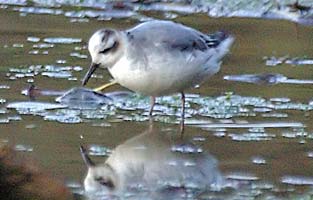 |  |  |
|
What to look for in October
October is the first month when 'winter' birds are seen. Unlike coastal migration watchpoints, the reservoir does not tend to attract rarities, but please prove me wrong!
There is a single Black-necked Grebe record in October.
A Great White Egret paid a brief visit in 2013 (another in 2022) and one of the three records of Spoonbill was in October 2011.A Brent Goose was recorded in 2014. Occasional Common Scoter have been seen in October with records in 1998 and 1999 when a Long tailed Duck was also seen. Goldeneye is a possibility at the end of the month.
An Osprey was seen in 2000 at the begining of the month, but it is rather late in the year for these magnificent birds.
The maximum ever count of 315 Coot was in October 1958.
The occasional Water Rail may take up winter residence
from October onwards.
The wader numbers, never high at Chard, tail off in October, but up to
3 Green Sandpipers have been seen together and there
are 2 records of Dunlin and Greenshank.
A single Phalarope was seen in 1933 and another Grey
Phalarope found on 21st Oct 2008. Also a Little Ringed
Plover stayed for a few days in 2013.
Only a small number of Terns might appear in the first few days of the month, but this is one of the best months for Mediterranean Gulls.
Not generally very common at Chard reservoir, up to 150 Pied Wagtails have been recorded to roost in October. Small falls of Goldcrests can occur this month, please attempt to count any parties you see as this known phenomenon is not often properly recorded. There is also the slight possibility of a Firecrest amongst these birds. Apart from my stringy possible sighting in January 2012, the only Yellow-browed Warbler record is from October 2013.
The first Redwings arrive in October from Scandinavia for the winter, often heard before they are seen. Watch out for increased Blackbird numbers too, also from Scandinavia.
